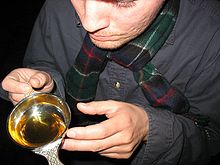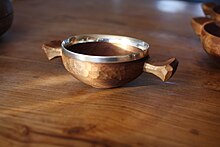Quaich
This article has multiple issues. Please help improve it or discuss these issues on the talk page. (Learn how and when to remove these template messages)
|

A quaich
History
According to the
In his 1955

Traditionally quaichs are made of wood, an artform known as "

The origin of quaichs in Scotland is traced to the Highlands[citation needed]; it was not until the end of the 17th century that they became popular in such large centres as Edinburgh and Glasgow. The silversmiths of such local guilds as Inverness and Perth frequently mounted them in silver, as may be seen from the hallmarks on the existing examples.[1]
Commemorative quaichs awarded as prizes, or given as gifts, are more commonly made of pewter or silver. These prize cups are rarely used for actual drinking.[1]
Related vessels to the Scottish quaich include the
The quaich was used for
Wooden commemorative quaichs designed by Paul Hodgkiss were given as presents to winners at the 2014 Commonwealth Games in Glasgow.[5]
See also
- Loch Quoich
- Glen Quaich
- Centenary Quaich – a rugby football competition
Notes
- ^ a b c d Jones 1911, p. 708.
- ^ McClenahan 1955, p. 3.
- ^ The Scotsman's staff 2010.
- ^ a b The Herald staff 1994.
- ^ BBC staff 2014.
References
- BBC staff (25 July 2014), Glasgow 2014: A quaich guide to the medallists' truly Scottish gifts, BBC News, retrieved 31 July 2014
- The Herald staff (21 April 1994), "Priceless heirlooms lost from Scott's home. Thieves take Abbotsford treasures", The Herald
- McClenahan, Richard L. (1955), Some Scottish Quaichs, Illinois, p. 3
{{citation}}: CS1 maint: location missing publisher (link) - The Scotsman's staff (18 March 2010), "Sir Walter Scott", The Scotsman, retrieved 7 July 2015
Attribution:
- This article incorporates text from a publication now in the public domain: Jones, E. Alfred (1911). "Quaich". In Chisholm, Hugh (ed.). Encyclopædia Britannica. Vol. 22 (11th ed.). Cambridge University Press. p. 708.
